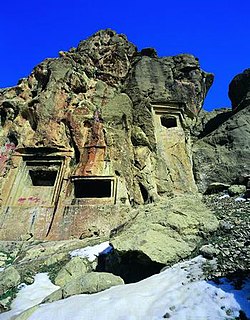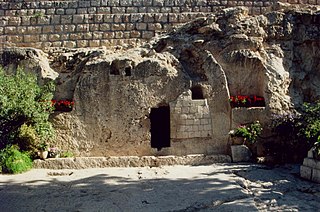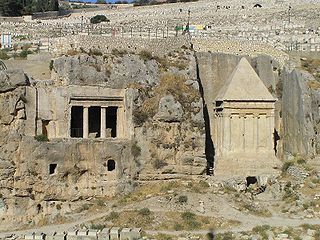 W
WA rock-cut tomb is a burial chamber that is cut into an existing, naturally occurring rock formation, so a type of rock-cut architecture. They are usually cut into a cliff or sloping rock face, but may go down from fairly flat ground. It was a common form of burial for the wealthy in ancient times in several parts of the world.
 W
WAd Deir, also spelled ad-Dayr and el-Deir, is a monumental building carved out of rock in the ancient Jordanian city of Petra. The Deir was probably carved out of the rock in the mid-first century CE.
 W
WBeit She'arim is the currently used name for the ancient Jewish town of Bet She'arāyim or Kfar She'arāyim, made popular by its necropolis, now known as Beit She'arim National Park. The site, located on a hill, was known initially by its Arabic name Sheikh Ibreik or Sheikh Abreik, purchased by the Jewish National Fund, and which historical geographer Samuel Klein in 1936 identified as Talmudic Beit She'arim.
 W
WThe Cave of Nicanor is an ancient burial cave located on Mount Scopus in Jerusalem, Israel. Among the ossuaries discovered in the cave is one with an inscription referring to "Nicanor the door maker". The cave is located in the National Botanic Garden of Israel on the grounds of the Mount Scopus campus of the Hebrew University of Jerusalem.
 W
WThe Cave of the Minor Sanhedrin is a burial cave located next to the Tomb of Simeon the Just in the Sheikh Jarrah neighborhood of Jerusalem. It contains 26 burial niches, in which the 26 members of the Minor Sanhedrin are said to be buried. There are also other burial caves in the complex.
 W
WThe Cave of the Ramban is located in the southern cliff of the Upper Kidron Valley, on a slope descending into the Arab neighborhood of Wadi al-Joz, Jerusalem. It is believed by some to be the traditional burial place of Nahmanides, a foremost rabbinical scholar during the medieval era.
 W
WDekhmeye Rawansar or Koshk is a rock-cut tomb located near the town of Ravansar, about 57 km northwest of Kermanshah, at west of Iran. This tomb was known to Ernst Herzfeld but he never visited it. The first archaeologist who visited the tomb was Massoud Golzari, an Iranian archaeologist who attributed it to Medes. It is re-visited and examined by Peter Calmeyer, German archaeologist in the 1970s, who according to his observations related the tomb to the Achaemenid period.
 W
WThe Essaqwand Rock Tombs are three rock-hewn tombs located 25 km southwest of Harsin in Kermanshah Province, Iran. On top of the middle tomb there is a rock relief of a man with his profile toward the viewers. He is holding his hands in prayers in front of him. There is also a torch and a fire altar in front of him. Behind the fire altar there is another man, holding up something in his hands. The tombs have been attributed to different historical eras including Medes, Achaemenids, Seleucids and Parthians.
 W
WThe rock tomb of Fakhrigah lies 15 km to the northeast of Mahabad, in West Azerbaijan Province, western Iran. It is located along the Mahabad−Miandoab Road south of the village of Inderghash in Iranian Kurdistan.
 W
WThe Garden Tomb is a rock-cut tomb in Jerusalem, which was unearthed in 1867 and is considered by some Protestants to be the site of the burial and resurrection of Jesus. The tomb has been dated by Israeli archaeologist Gabriel Barkay to the 8th–7th centuries BC. The re-use of old tombs was not an uncommon practice in ancient times, but this would contradict the biblical text that speaks of a new, not reused, tomb made for himself by Joseph of Arimathea. Also, the trough in front of the tomb and the nearby cistern, described by proponents of the Garden Tomb as part of the tomb's sealing system and as the surrounding garden's source of water, respectively, have both been archaeologically dated to the Crusader period. The organisation maintaining the Garden Tomb refrains from claiming that this is the authentic tomb of Jesus, while pointing out the similarities with the site described in the Bible, and the fact that the Garden Tomb better preserves its ancient outlook than the more traditional, but architecturally altered and time-damaged tomb from the mostly crowded Church of the Holy Sepulchre; for all of these reasons, they suggest that the Garden Tomb is more evocative of the events described in the Gospels.
 W
WLycia was a geopolitical region in Anatolia in what are now the provinces of Antalya and Muğla on the southern coast of Turkey, bordering the Mediterranean Sea, and Burdur Province inland. Known to history since the records of ancient Egypt and the Hittite Empire in the Late Bronze Age, it was populated by speakers of the Luwian language group. Written records began to be inscribed in stone in the Lycian language after Lycia's involuntary incorporation into the Achaemenid Empire in the Iron Age. At that time (546 BC) the Luwian speakers were decimated, and Lycia received an influx of Persian speakers. Ancient sources seem to indicate that an older name of the region was Alope.
 W
WThe Monolith of Silwan, also known as the Tomb of Pharaoh's Daughter, is a cuboid rock-cut tomb located in Silwan, Jerusalem dating from the period of the Kingdom of Judah; the latter name refers to a 19th-century hypothesis that the tomb was built by Solomon for his Egyptian wife. The structure, a typical Israelite rock-cut tomb, was previously capped by a pyramid structure like the Tomb of Zechariah. It is one of the more complete and distinctive First Temple-period structures. The pyramidal, rock cap was cut into pieces and removed for quarry, during the Roman era leaving a flat roof. The tomb contains a single stone bench, indicating that it was designed for only one burial. Recent research indicates that the bench was the base of a sarcophagus hewn into the original building.
 W
WNaqsh-e Rostam is an ancient necropolis located about 12 km northwest of Persepolis, in Fars Province, Iran, with a group of ancient Iranian rock reliefs cut into the cliff, from both the Achaemenid and Sassanid periods. It lies a few hundred meters from Naqsh-e Rajab, with a further four Sassanid rock reliefs, three celebrating kings and one a high priest.
 W
WPetra, originally known to its inhabitants in as Raqmu or Raqēmō (𐢚𐢛𐢓𐢈), is a historic and archaeological city in southern Jordan. Petra lies around Jabal Al-Madbah in a basin surrounded by mountains which form the eastern flank of the Arabah valley that runs from the Dead Sea to the Gulf of Aqaba. The area around Petra has been inhabited from as early as 7000 BC, and the Nabataeans might have settled in what would become the capital city of their kingdom, as early as the 4th century BC. However, archaeological work has only discovered evidence of Nabataean presence dating back to the second century BC, by which time Petra had become their capital. The Nabataeans were nomadic Arabs who invested in Petra's proximity to the trade routes by establishing it as a major regional trading hub.
 W
WJason's Tomb is a rock-cut tomb dating to the first century BCE in the Hasmonean period, discovered in the Rehavia neighborhood in Jerusalem, Israel. It has been identified as the burial site of a certain Jason, possibly a naval commander, based on the charcoal drawing of two warships discovered in the cave.
 W
WRock-cut tombs are a form of burial and interment chamber used in ancient Israel. Cut into the landscapes surrounding ancient Judean cities, their design ranges from single chambered, with simple square or rectangular layouts, to multi-chambered with more complex designs. Almost all burial chambers contain a platform for primary burial and an ossuary or other receptacle for secondary burial. There is debate on if these tombs were originally intended for secondary burials, or if that practice arose later. The use of rock-cut cave tombs in the region began in the early Canaanite period, from 3100–2900 BCE. The custom lapsed a millennium, however, before reemerging in the earliest Israelite tombs, dating to the 9th century BCE in Jerusalem. The use of rock-cut tombs reached its peak in the 7th and 8th centuries BCE, before rapidly declining and eventually falling out of use in the 6th century BCE in some regions. Use of the tombs has been recorded as recently as the Late Roman Period around the 3rd century CE. The use of such tombs was generally reserved for the middle- and upper-classes, and each typically belonged to a single nuclear or extended family.
 W
WThe Talpiot Tomb is a rock-cut tomb discovered in 1980 in the East Talpiot neighborhood, five kilometers south of the Old City in East Jerusalem. It contained ten ossuaries, six inscribed with epigraphs, including one interpreted as "Yeshua bar Yehosef", though the inscription is partially illegible, and its translation and interpretation is widely disputed. The tomb also yielded various human remains and several carvings.
 W
WTomb of Absalom, also called Absalom's Pillar, is an ancient monumental rock-cut tomb with a conical roof located in the Kidron Valley in Jerusalem, a few metres from the Tomb of Zechariah and the Tomb of Benei Hezir. Although traditionally ascribed to Absalom, the rebellious son of King David of Israel, recent scholarship has dated it to the 1st century CE.
 W
WThe Tomb of Benei Hezir, previously known as the Tomb of Saint James, is the oldest of four monumental rock-cut tombs that stand in the Kidron Valley, adjacent to the Tomb of Zechariah and a few meters from the Tomb of Absalom. It dates to the period of the Second Temple. It is a complex of burial caves. The tomb was originally accessed from a single rock-cut stairwell which descends to the tomb from the north. At a later period an additional entrance was created by quarrying a tunnel from the courtyard of the monument known as "the Tomb of Zechariah". This is also the contemporary entrance to the burial complex.
 W
WThe tomb of Darius the Great is one of the four tombs of Achaemenid kings at the historical site of Naqsh-e Rustam located about 12 km northwest of Persepolis, Iran. They are all at a considerable height above the ground.
 W
WThe Tomb of Simeon the Just or Simeon the Righteous is an ancient tomb in Jerusalem. According to scholarly consensus, based on an in situ inscription, it is the 2nd-century CE burial site of a Roman matron named Julia Sabina. However, according to a medieval Jewish tradition, is believed to be the burial place of Simeon the Just and his students. It is located adjacent to the Cave of the Minor Sanhedrin in the Shimon HaTzadik city quarter adjoining Sheikh Jarrah neighborhood.
 W
WThe Tomb of the Prophets Haggai, Zechariah and Malachi is an ancient burial site located on the upper western slope of the Mount of Olives, Jerusalem. According to a medieval Jewish tradition also adopted by Christians, the catacomb is believed to be the burial place of Haggai, Zechariah and Malachi, the last three Hebrew Bible prophets who are believed to have lived during the 6th-5th centuries BC. Archaeologists have dated the three earliest burial chambers to the 1st century BC, thus contradicting the tradition.
 W
WThe tomb of Ture Malmgren is a structure located in Uddevalla, Bohuslän, Sweden. It is located by the foot of Fjällsätern, near the center of the residential district of Tureborg. Carved into the sheer cliff face, it was intended as the final resting place of the local politician and publicist Ture Malmgren. Despite his own wishes, Malmgren was instead interred elsewhere after his death in 1922, effectively rendering the empty rock-cut tomb a cenotaph of sorts.
 W
WThe Tomb of Zechariah is an ancient stone monument adjacent to the Tomb of Benei Hezir that is considered in Jewish tradition to be the tomb of Zechariah ben Jehoiada. It is a few meters from the Tomb of Absalom and adjacent to the Tomb of Benei Hezir.
 W
WThe Tombs of the Kings are a rock-cut funerary complex in East Jerusalem believed to be the burial site of Queen Helene of Adiabene. The tombs are located 820 meters north of Jerusalem's Old City walls in the Sheikh Jarrah neighborhood
 W
WThe Tombs of the kings of Pontus, located in Amasya, northern Turkey, are rock-carved tombs of different size, forming the royal necropolis of the Pontic kings.
 W
WTombs of the Sanhedrin, also Tombs of the Judges, is an underground complex of 63 rock-cut tombs located in a public park in the northern Jerusalem neighborhood of Sanhedria. Built in the 1st century CE, the tombs are noted for their elaborate design and symmetry. They have been a site for Jewish pilgrimage since the medieval period. The popular name of the complex, which has the most magnificently carved pediment of ancient Jerusalem, is due to the fact that the number of burial niches it contains is somewhat close to that of the members of the ancient Jewish supreme court, the Great Sanhedrin, namely 71.
 W
WThe Valley of the Kings, also known as the Valley of the Gates of the Kings, is a valley in Egypt where, for a period of nearly 500 years from the 16th to 11th century BC, rock-cut tombs were excavated for the pharaohs and powerful nobles of the New Kingdom.